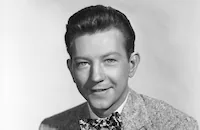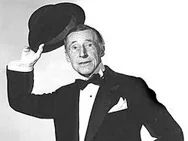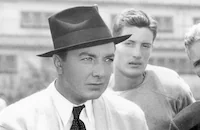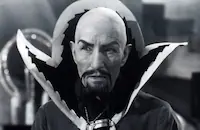Feudin', Fussin and A-Fightin'
Brief Synopsis
Cast & Crew
George Sherman
Donald O'connor
Marjorie Main
Percy Kilbride
Penny Edwards
Joe Besser
Film Details
Technical Specs

Synopsis
As the town of Rimrock prepares for its annual footrace with neighboring town Big Bend, the citizens express disappointment with their runner, Milton Wurtle. Therefore, when hair tonic salesman Wilbur McMurtry stops in town and demonstrates his extreme speed by running for a stagecoach, townspeople Sharkey Dolan and Billy Caswell and mayor Maribel Matthews chase after the stagecoach and arrest Wilbur on trumped-up charges. After releasing their previous captive, Milton, they lock him in a barn and reveal that they have kidnapped him in order to enter him into the race. Later, Maribel's niece, Libby, feeds him in the barn, explaining that the race is very important because if they lose to Big Bend, they will be losing their homes, businesses and all their money. Wilbur succumbs to Libby's charm and tells her that he will consider running. During a town meeting, citizens place bets on the race, and after Maribel convinces Big Bend's representative, Chauncey, to give them five to one odds, she bets the town hall, school house, cash and livestock. Suspicious, Chauncey instructs his entry, blacksmith Emory Tuttle, to court Libby in order to spy on Wilbur. After Emory makes sure that Libby overhears him "admitting" that he is in love with her, she tells him the feeling is mutual. Wilbur enters the barn when he spies them kissing, and Emory tells Wilbur to stay away from Libby, as she is going to marry him. The next morning, Wilbur begins training by racing against Sharkey, and after he loses, Maribel tells the nervous townspeople that he lost on purpose to throw off Emory. Soon after, Wilbur stops eating, and Maribel hires a veterinarian, Overholt, to examine him, not realizing that Overholt is crooked. When Libby visits him, Wilbur shows her an anonymous threatening letter that was thrown through the barn window, and Libby agrees to escape with him while the armed guard takes his morning break. The next morning, Wilbur escapes, but is quickly captured again by Sharkey. Meanwhile, Overholt instructs Emory to give Wilbur a potion that will make him unable to run. Later, in the stable, Wilbur angrily accuses Libby of framing him, and threatens to refuse to run unless he is allowed to attend the town's pre-race dance that night. As soon as Wilbur leaves the stables to go to the dance, however, Emory sneaks in and drops the potion in his water bucket, which the horse, Jasper, drinks. At the dance, Libby becomes jealous when Wilbur dances with other women, but soon makes up with him and again promises to leave town with him. When Wilbur returns to the stable, he sees Jasper on the ground and notifies Overholt. The veterinarian attempts to exhaust Wilbur by instructing him to walk Jasper all night. Just before the race begins the next morning, Maribel finds Wilbur and, realizing that his hair tonic can be used as a rejuvenator, uses it to wake him, but then forgets to bring it along with them to the race. She sends Billy back to town to get it, but Billy's horse breaks a shoe and he is forced to ride Jasper to the race. Realizing Jasper is still too tired to get him back in time, Billy gives some of the hair tonic to the horse. Meanwhile, at the race, Wilbur stops to rest, sees a rattlesnake and, scared, runs quickly enough to pass Emory. He then slows down again and sits on a porcupine, which spurs him on to greater speeds. At a spot near the finish line, Libby and Billy watch Emory and Wilbur approaching and see that Emory is in the lead. They give Wilbur the rest of the tonic, causing him to pull ahead and win. Later, Libby informs Billy and Sharkey that Rimrock has offered Wilbur the mayorship. A drunken Billy asks the Rimrock crowd if they want Wilbur as their mayor, and the cheering is unanimous. Maribel then accepts Billy's proposal of marriage.

Director
George Sherman
Cast

Donald O'connor

Marjorie Main

Percy Kilbride

Penny Edwards
Joe Besser
Harry Shannon

Fred Kohler Jr.
Howland Chamberlin
Edmund Cobb
Joel Friedkin
I. Stanford Jolley
The Sportsmen Quartette
Louis Da Pron
Alvin Hammer

Charles Middleton

Kenneth Macdonald
Herbert Heywood
Hank Worden
Harry Brown
Arthur Miles
Gene Stutenroth
Francis Williams
Roy Butler
Bill Sundholm
Monte Montague
Francis Ford
Tommy Coats
Al Murphy
Rex Lease
Robert O'neil
John Carpenter
John Beck
Jasper Palmer
Fred Fox
Lane Bradford
Crew
D. D. Beauchamp
E. Brown
Leslie I. Carey
Clifford Cling
Edward Curtiss
Louis Dapron
Paul Denniker
Richard Deweese
Carmen Dirigo
Dave Dreyer
Al Dubin
Russell A. Gausman
Irving Glassberg
Leonard Goldstein
Bernard Herzbrun
Horace Hough
Ray L. Jeffers
Al Jolson
Burton Lane
Rosemary Odell
Andy Razaf
Frank A. Richards
Billy Rose
Aaron Rosenberg
Leith Stevens
Keith Weeks
Bud Westmore

Photo Collections
Videos
Movie Clip



Film Details
Technical Specs

Articles
Murder, He Says/Feudin', Fussin' and A-Fightin' - Murder, He Says & Feudin', Fussin' and A-Fightin' - Double Feature on DVD
1945's Murder, He Says has gathered a reputation as a precocious and often hilarious black comedy that transplants the daffy spirit of old James Whale horror films into the hillbilly genre. Whale's The Old Dark House and The Invisible Man also function as the kind of macabre comedies that Charles Addams would have enjoyed. Paramount found success with a pair of haunted house pictures for Bob Hope, but this show stars the versatile Fred MacMurray, who had distinguished himself in light comedies and recently proved his dramatic chops in Billy Wilder's Double Indemnity. With future film noir fixture Helen Walker as a mysterious leading lady and MacMurray's Indemnity alumni Porter Hall and Jean Heather creeping through hidden passageways, Murder, He Says has plenty of familiar faces.
Pollster Hector P. Smedley has disappeared in the backwoods, and his backup Pete Marshall (MacMurray) is dispatched to find him. Even the locals stay clear of the murderous Fleagles, but Pete breezes right in to their run-down crazy house, far beyond the reach of the law. Each of the Fleagles is insane, in a different way. Twin yahoos Mert and Bert (Peter Whitney) threaten to blow Pete in two with a shotgun, while the beautiful but wild-eyed Elany (Jean Heather) wanders the halls in a trance. Eccentric Mr. Johnson (Porter Hall) has a habit of disappearing behind secret doors. Matriarch Mamie Fleagle keeps Pete alive because he might be able to convince senile Grandma (Mabel Paige) to divulge the whereabouts of the loot stolen by Bonnie Fleagle, now residing in prison. Grandma trusts Pete more than her own venal kinfolk and gives him a clue -- a song melody. The treasure hunt is interrupted by the arrival of the pistol-packing bandit Bonnie -- who is really the romantic Claire Matthews (Helen Walker), just pretending to be tough to keep the Fleagles at bay and grab the loot for herself.
Murder, He Says is an unbroken series of word games, crazy killers, slapstick chases and death threats, all of which Fred MacMurray reacts to with cheerful aplomb. MacMurray's easygoing attitude gives the film's collection of weird events a dreamlike quality that Luis Buñuel might have admired. Escaping from the shotgun-toting Mert and Bert, Pete hitches a ride in a truck, which takes him right back to the hillbilly death house. A glowing ghost in the night turns out to be one of the Fleagle's hounds, covered with a luminous toxin. A subsequent murder attempt involves a bowl of soup laced with this poison. With all the bowls spinning around the table on a lazy-Susan device, nobody knows who has sipped a lethal dose until yet another victim begins glowing like a monster from a Universal horror film.
The supporting cast has a grand time with their wacky characters. Marjorie Main's domineering Mamie and Porter Hall's conniving madman are little gems of performance, and the unheralded Peter Whitney is fine in as twin oafs, only one of which can be immobilized by a fast slam to an Achilles-like crick in his back. The special effects that show the actor playing against himself, often in the same frame, are completely convincing.
In a fetching Daisy Mae hairstyle, pretty Helen Walker comes off as a much softer presence than her icy schemer in the celebrated Nightmare Alley. She makes for a sexy Bonnie Parker type, ordering the Fleagles about at the point of a gun until the real gangster dame (feisty Barbara Pepper) shows up. Murder, He Says maintains a giddy, very non-Hollywood sense of imbalance right through the silly ending where all the villains tumble into a hay baler -- the movie winds up as we imagine Preston Sturges' imaginary rural romp "Hey Hey in the Hayloft" might. Either that, or the movie will remind modern audiences of Tobe Hooper's The Texas Chainsaw Massacre, another tale of degenerate yahoos running a rural death trap. At the jolly finish of Murder, He Says, the luckless first victim of the deadly Fleagles has been entirely forgotten.
Always a popular performer, ace dancer Donald O'Connor achieved immortality as Gene Kelly's hoofing sidekick in Singin' in the Rain but earned his bread and butter in a series of less prestigious but always entertaining musical vehicles. One of these is 1948's Feudin', Fussin' and A-Fightin', a budget minded Universal effort that affords O'Connor three pleasant song 'n' dance numbers, and leaves the rest of the movie to whatever resources are available on the Universal lot. Although technically taking place in the Old West, the show earns its Hick Pix credentials with the presence of Marjorie Main as yet another sentimental rural battleaxe. She is paired with Percy Kilbride for the first time since The Egg and I: their official Ma and Pa Kettle series was still in the planning stages.
The story makes use of Universal's western back lot, minimizing the need for budget items like horses and guns. Salesman Wilbur McMurty (O'Connor) breezes into Rimrock, a tiny town engaged in a bitter competition with neighboring Big Bend. Rimrock needs a champion runner to go up against Big Bend's burly blacksmith. With Rimrock mortgaged to the hilt, mayor Maribel Mathews (Marjorie Main) has bet most of the town's money on the race and must somehow come up with a winning candidate. Seeing Wilbur sprint after a departing stagecoach, she has sheriff Sharkey (sometime Stooge Joe Besser) lock the salesman in the livery stable, where his only company until he agrees to race will be his own shadow. This cues a clever dance number set to Al Jolson, Billy Rose and Dave Dreyer's "Me and My Shadow"; O'Connor does his patented dance move in which he runs up a wall and flips backwards onto his feet. When Wilbur gets a look at Maribel's beautiful daughter Libby (Penny Edwards), he finds the motivation to compete in good faith. That is, if he gets a chance: the heavy wagers between Rimrock and Big Bend have upped the incentive to cheat.
Feudin', Fussin' and A-Fightin' is a middling star vehicle that barely does service to the talented Donald O'Connor, who would nevertheless keep making similar movies for the next ten years. Screenwriter D.D. Beauchamp does his best to enliven the generic proceedings that climax in a slapstick footrace through Universal's back lot acreage. Wilbur has been tricked into staying up all night walking a sick horse and can barely stay awake for the race. The humor is on the silly side, as when Wilbur repeatedly falls in a brook and is washed downstream, each time emerging from the water with a larger fish in his hands. Earlier on, the screenwriter squeezes some mileage from the idea that Wilbur is being treated and trained like a racehorse. Maribel and her beau, the somewhat passive Billy Caswell (Percy Kilbride) make Wilbur trot in a circle, and the veterinarian checks his fitness by examining his teeth.
In time-honored comedy fashion, Wilbur is too bashful to declare his love to Penny and instead directs his words through a friendly horse. For viewers familiar with O'Connor's Francis the Talking Mule comedy series, these scenes almost seem prophetic. Watch out Donald! When the animals start talking back you'll be sharing marquee space with a long-eared co-star.
Cute Penny Edwards has plenty of dancing talent but was soon working in low profile westerns. The film directs more of its attention at the Marjorie Main / Percy Kilbride relationship. The outspoken Maribel uses the quiet Billy as a floor mat and claims that she won't remarry until she finds a man strong enough to order her about. In keeping with postwar gender politics, Billy Caswell wins his mate by showing her who's boss -- and depriving her of her job as mayor.
The TCM Vault Collection's Double Bill DVD of Murder, He Says and Feudin', Fussin' and A-Fightin' is an interesting comedy pairing. The rich transfer of Murder, originally a Paramount release, flatters Theodor Sparkuhl's deep blacks - almost all of the movie takes place at night. The Universal-International programmer Feudin', Fussin' and A-Fightin' doesn't fare as well. The source appears light and soft, and is probably from a surviving 16mm element. A few scratches also intrude, but the film is intact and the audio clear.
The features come on separate discs. TCM has augmented them with galleries of stills & artwork, and informative essays culled from the research database of the TCM website.
For more information about Murder, He Says/Feudin', Fussin' and A-Fightin', visit TCM Vault Collection. To order Murder, He Says/Feudin', Fussin' and A-Fightin', go to TCM Shopping.
by Glenn Erickson

Murder, He Says/Feudin', Fussin' and A-Fightin' - Murder, He Says & Feudin', Fussin' and A-Fightin' - Double Feature on DVD
Feudin', Fussin and A-Fightin'
Feudin', Fussin' and A-Fightin' plays on much the same fish-out-of-water formula that made The Egg and I a hit. Fast-talking traveling salesman Wilbur McMurty (Donald O'Connor) is kidnapped by the citizens of Rimrock, perennial losers in the annual footrace against rival town Big Bend, because he proves himself fast enough to be the only likely contender with a chance to win. Literally a prisoner of the Western town, he's told that if he loses, it's curtains for him, so McMurty is understandably reluctant to compete, that is until he falls for the daughter (Penny Edwards) of the salty lady mayor (played by Main).
Musical highlights include a duet between O'Connor and Penny Edwards, a former Ziegfeld performer who went on from this to a number of Western roles, often subbing for a pregnant Dale Evans in Roy Rogers movies. There's also an appearance by the Sportsman Quartet, regulars on Jack Benny's show. And the studio, as it hoped, got a lot of comic mileage out of the interplay between Main as the mayor and Percy Kilbride as a local stableman who serves as her political assistant.
The film was in production as "The Wonderful Race at Rimrock," the name of the 1946 Collier's magazine story by D.D. Beauchamp on which he based the screenplay. Beauchamp's writing was the source for another Marjorie Main vehicle, as the title character in the Abbott and Costello comedy The Wistful Widow of Wagon Gap (1947). He wrote a few more films for Abbott and Costello, as well as several Westerns over the next decade and eventually found success writing for such television shows as Rawhide, The Virginian, and Gentle Ben. Some of Beauchamp's movie scripts were for George Sherman, the director of Feudin', Fussin' and A-Fightin', who also directed several Beauchamp-penned episodes of the frontier TV series Daniel Boone.
According to an article in the Hollywood Reporter published September 1948, producer Lee Shubert (of Shubert Theater fame) and the comedy team of Ole Olsen and Chic Johnson filed suit against Universal, claiming that they owned a sizable percentage of the motion picture rights to the title Feudin', Fussin' and A-Fightin' and the song "Feudin' and Fightin'" for which they felt they were not fairly compensated. That song, by Burton Lane and Al Dubin, was used in the movie, along with "S'posin'" and the Al Jolson standard "Me and My Shadow." The final disposition of the suit is not known.
Audiences may recognize Joe Besser, the actor playing the town sheriff, as the pudgy, balding player who made up the third of the Three Stooges (with Moe and Larry) after the deaths of the other two Howard brothers, Curly and Shemp, respectively (and before Joe DeRita). The part of Emory Tuttle is played by Fred Kohler, Jr., whose father appeared with the Stooges in a 1935 film.
Director: George Sherman
Producer: Leonard Goldstein
Screenplay: D.D. Beauchamp, based on his short story
Cinematography: Irving Glassberg
Editing: Edward Curtiss
Art Direction: Bernard Herzbrun, Frank A. Richards
Cast: Donald O'Connor (Wilbur McMurty), Marjorie Main (Maribel Matthews), Percy Kilbride (Billy Caswell), Penny Edwards (Libby Matthews), Joe Besser (Sharkey Dolan).
BW-78m.
by Rob Nixon
Feudin', Fussin and A-Fightin'
Donald O'Connor, 1925-2003
Born Donald David Dixon O' Connor in Chicago on August 28, 1925, he was raised in an atmosphere of show business. His parents were circus trapeze artists and later vaudeville entertainers, and as soon as young Donald was old enough to walk, he was performing in a variety of dance and stunt routines all across the country. Discovered by a film scout at age 11, he made his film debut with two of his brothers in Melody for Two (1937), and was singled out for a contract by Paramount Pictures. He co-starred with Bing Crosby and Fred MacMurray in Sing, You Sinners (1938) and played juvenile roles in several films, including Huckleberry Finn in Tom Sawyer - Detective (1938) and the title character as a child in Beau Geste (1939).
As O'Connor grew into adolescence, he fared pretty well as a youthful hoofer, dancing up a storm in a string of low-budget, but engaging musicals for Universal Studios (often teamed with the equally vigorous Peggy Ryan) during World War II. Titles like What's Cookin', Get Hep to Love (both 1942), Chip Off the Old Block and Strictly in the Groove (both 1943) made for some fairly innocuous entertainment, but they went a long way in displaying O'Connor's athletic dancing and boyish charm. As an adult, O'Connor struck paydirt again when he starred opposite a talking mule (with a voice supplied by Chill Wills) in the enormously popular Francis (1949). The story about an Army private who discovers that only he can communicate with a talking army mule, proved to be a very profitable hit with kids, and Universal went on to star him in several sequels.
Yet if O'Connor had to stake his claim to cinematic greatness, it would unquestionably be his daringly acrobatic, brazenly funny turn as Cosmo Brown, Gene Kelly's sidekick in the brilliant Singin' in the Rain (1952). Although his self-choreographed routine of "Make "Em Laugh" (which includes a mind-bending series of backflips off the walls) is often singled out as the highlight, in truth, his whole performance is one of the highlights of the film. His deft comic delivery of one-liners, crazy facial expressions (just watch him lampoon the diction teacher in the glorious "Moses Supposes" bit) and exhilarating dance moves (the opening "Fit As a Fiddle" number with Kelly to name just one) throughout the film are just sheer film treats in any critic's book.
After the success of Singin' in the Rain, O'Connor proved that he had enough charisma to command his first starring vehicle, opposite Debbie Reynolds, in the cute musical I Love Melvin (1953). He also found good parts in Call Me Madam (1953), There's No Business Like Show Business (1954), and Anything Goes (1956). Unfortunately, his one attempt at a strong dramatic role, the lead in the weak biopic The Buster Keaton Story (1957) proved to be misstep, and he was panned by the critics.
By the '60s, the popularity of musicals had faded, and O'Connor spent the next several years supporting himself with many dinner theater and nightclub appearances; but just when it looked like we wouldn't see O'Connor's talent shine again on the small or big screen, he found himself in demand at the dawn of the '90s in a string of TV appearances: Murder She Wrote, Tales From the Crypt, Fraser, The Nanny; and movies: Robin Williams' toy-manufacturer father in Toys (1992), a fellow passenger in the Lemmon-Matthau comedy, Out to Sea (1997), that were as welcoming as they were heartening. Survivors include his wife, Gloria; four children, Alicia, Donna, Fred and Kevin; and four grandchildren.
by Michael T. Toole
Donald O'Connor, 1925-2003
Quotes
Trivia
Notes
The working title of this film was The Wonderful Race at Rimrock. According to a September 1948 Hollywood Reporter article, Lee Shubert and Ole Olsen and Chic Johnson of Olsen and Johnson fame filed suit against Universal, claiming that they owned forty percent of the motion picture rights to the title Feudin', Fussin' and A-Fighting and the song "Feudin' and Fightin'" and were not fairly compensated for their use. The final disposition of the suit is not known.














